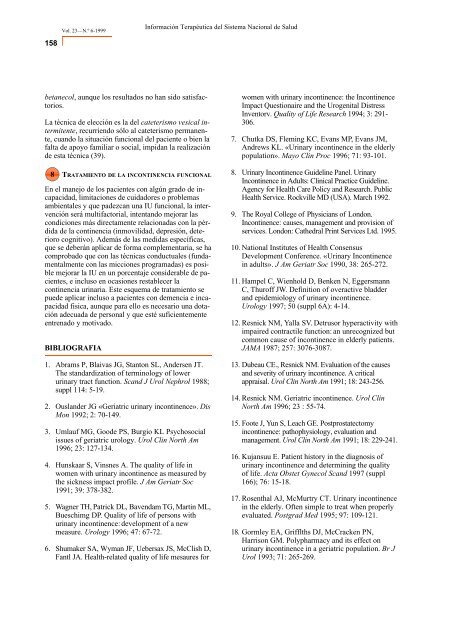incontinencia
incontinencia
incontinencia
Create successful ePaper yourself
Turn your PDF publications into a flip-book with our unique Google optimized e-Paper software.
158<br />
Vol. 23—N.º 6-1999<br />
betanecol, aunque los resultados no han sido satisfactorios.<br />
La técnica de elección es la del cateterismo vesical intermitente,<br />
recurriendo sólo al cateterismo permanente,<br />
cuando la situación funcional del paciente o bien la<br />
falta de apoyo familiar o social, impidan la realización<br />
de esta técnica (39).<br />
8<br />
TRATAMIENTO DE LA INCONTINENCIA FUNCIONAL<br />
En el manejo de los pacientes con algún grado de incapacidad,<br />
limitaciones de cuidadores o problemas<br />
ambientales y que padezcan una IU funcional, la intervención<br />
será multifactorial, intentando mejorar las<br />
condiciones más directamente relacionadas con la pérdida<br />
de la continencia (inmovilidad, depresión, deterioro<br />
cognitivo). Además de las medidas específicas,<br />
que se deberán aplicar de forma complementaria, se ha<br />
comprobado que con las técnicas conductuales (fundamentalmente<br />
con las micciones programadas) es posible<br />
mejorar la IU en un porcentaje considerable de pacientes,<br />
e incluso en ocasiones restablecer la<br />
continencia urinaria. Este esquema de tratamiento se<br />
puede aplicar incluso a pacientes con demencia e incapacidad<br />
fisica, aunque para ello es necesario una dotación<br />
adecuada de personal y que esté suficientemente<br />
entrenado y motivado.<br />
BIBLIOGRAFIA<br />
1. Abrams P, Blaivas JG, Stanton SL, Andersen JT.<br />
The standardization of terminology of lower<br />
urinary tract function. Scand J Urol Nephrol1988;<br />
suppl 114: 5-19.<br />
2. Ouslander JG «Geriatric urinary incontinence». Dis<br />
Mon1992; 2: 70-149.<br />
3. Umlauf MG, Goode PS, Burgio KL Psychosocial<br />
issues of geriatric urology. Urol Clin North Am<br />
1996; 23: 127-134.<br />
4. Hunskaar S, Vinsnes A. The quality of life in<br />
women with urinary incontinence as measured by<br />
the sickness impact profile. J Am Geriatr Soc<br />
1991; 39: 378-382.<br />
5. Wagner TH,Patrick DL, BavendamTG,Martin ML,<br />
Bueschimg DP. Quality of life of persons with<br />
urinary incontinence:development of a new<br />
measure. Urology1996; 47: 67-72.<br />
6. Shumaker SA, Wyman JF, Uebersax JS, McClish D,<br />
Fantl JA. Health-related quality of life mesaures for<br />
Información Terapéutica del Sistema Nacional de Salud<br />
women with urinary incontinence: the Incontinence<br />
Impact Questionaire and the Urogenital Distress<br />
Inventorv. Quality of Life Research1994; 3: 291-<br />
306.<br />
7. Chutka DS, Fleming KC, Evans MP, Evans JM,<br />
Andrews KL. «Urinary incontinence in the elderly<br />
population». Mayo Clin Proc1996; 71: 93-101.<br />
8. Urinary Incontinence Guideline Panel. Urinary<br />
Incontinence in Adults: Clinical Practice Guideline.<br />
Agency for Health Care Policy and Research. Public<br />
Health Service. Rockville MD (USA). March 1992.<br />
9. The Royal College of Physicians of London.<br />
Incontinence:causes, managementand provision of<br />
services. London: Cathedral Print Services Ltd. 1995.<br />
10.National Institutes of Health Consensus<br />
Development Conference. «Urinary Incontinence<br />
in adults». J Am Geriatr Soc1990, 38: 265-272.<br />
11.Hampel C, Wienhold D, Benken N, Eggersmann<br />
C, Thuroff JW. Definition of overactive bladder<br />
and epidemiology of urinary incontinence.<br />
Urology1997; 50 (suppl 6A): 4-14.<br />
12.Resnick NM, Yalla SV.Detrusor hyperactivity with<br />
impaired contractile function:an unrecognized but<br />
common cause of incontinence in elderly patients.<br />
JAMA1987; 257: 3076-3087.<br />
13.Dubeau CE., Resnick NM. Evaluation of the causes<br />
and severity of urinary incontinence. A critical<br />
appraisal. Urol Clin North Am1991; 18: 243-256.<br />
14.Resnick NM. Geriatric incontinence. Urol Clin<br />
North Am1996; 23 : 55-74.<br />
15.Foote J, Yun S, Leach GE. Postprostatectomy<br />
incontinence: pathophysiology, evaluation and<br />
management. Urol Clin North Am1991; 18: 229-241.<br />
16.Kujansuu E. Patient history in the diagnosis of<br />
urinary incontinence and determining the quality<br />
of life. Acta Obstet Gynecol Scand1997 (suppl<br />
166); 76: 15-18.<br />
17.Rosenthal AJ, McMurtry CT. Urinary incontinence<br />
in the elderly. Often simple to treat when properly<br />
evaluated. Postgrad Med 1995; 97: 109-121.<br />
18. Gormley EA, Grifflths DJ, McCracken PN,<br />
Harrison GM. Polypharmacy and its effect on<br />
urinary incontinence in a geriatric population. Br J<br />
Urol1993; 71: 265-269.


